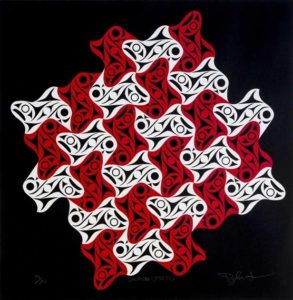Camosun University Transfer alumnus Dylan Thomas (Qwul’thilum) grew up listening to stories about the importance of salmon. It’s not just a food resource to coastal BC, he says—it’s a source of art and culture.
Thomas is a Coast Salish artist from the Lyackson First Nation, and the story passed down to him from his mother’s great grandmother says that people used to be able to walk across the Nanaimo River on the backs of salmon. But today, salmon stocks are depleting. Powerful images in various myths—such as the Cowichan Thunderbird and Orca Legend—have described this depletion, and now Thomas’ piece “Salmon Spirits”—which is featured in Where Two Waters Meet, an exhibition of Coast Salish contemporary art—hones in on this idea.
“Salmon Spirits” was from Thomas’ early days as an artist, but he decided to put it in this exhibit because it’s never been more relevant.
“Salmon has been a part of my art career from day one,” says Thomas.

Thomas grew up in a generation where he was always hearing about salmon numbers dropping; he decided to work with that, and also to work from the inspiration of Dutch graphic artist M.C. Escher for his piece.
“The M.C. Escher-style constellation with all the salmon crammed together was a good way to kind of show the crowding of the salmon’s spirit in the spirit world,” says Thomas. [“‘Salmon Spirits’ is] showing an overpopulation of salmon in the spirit world because there’s a depletion of salmon in the Earth-sea realm. That’s why I titled that one ‘Salmon Spirits.’”
Thomas—who was at Camosun in 2014 and designed the logo for Camosun’s 50th anniversary celebrations this year—talks openly about the state of coastal BC, saying that the salmon population plays heavily into culture. For thousands of years, it’s been the backbone of both sustenance and art for the region.
“For me, salmon were pretty much the lifeblood of most coastal people. The salmon numbers were the reason that the population grew so big in this area. Why social complexity reached such a high level has a lot to do with it. Food was abundant because of it. That’s why the art became so sophisticated,” he says. “I truly believe that salmon itself was one of the reasons that our art form and our culture reached such a level of sophistication.”
Thomas explains that being a hunter-gatherer culture, there’s a lot less time to focus on things like artwork if food isn’t plentiful. Knowing the relationship between salmon supply, culture, and art, it’s easy to get pessimistic about the future, but there has been success on small levels, he says. For example, there are certain rivers where the salmon are starting to come back.
“It’s amazing what we can do when the will of the people actually does change,” says Thomas. “There’s a lot going horribly wrong in the world today, but there’s also lots of things that we’ve made so much progress on.”
For Thomas, that progress can be in areas such as fishing, LGBTQ2S+ rights, or the racism in Canada today.
“I haven’t dealt with the type of racism that I dealt with as a kid where people were a lot more willing just to say things to you that would be shocking now,” he says. “We’ve made a lot of progress on so many avenues, but I think that changing peoples’ minds, and their disposition to the issues, is one of the most important things you can do.”
See more about Thomas’ art here.
Where Two Waters Meet
Until Sunday, June 27
Victoria Arts Council Vault, 1800 Store Street
vicartscouncil.ca
